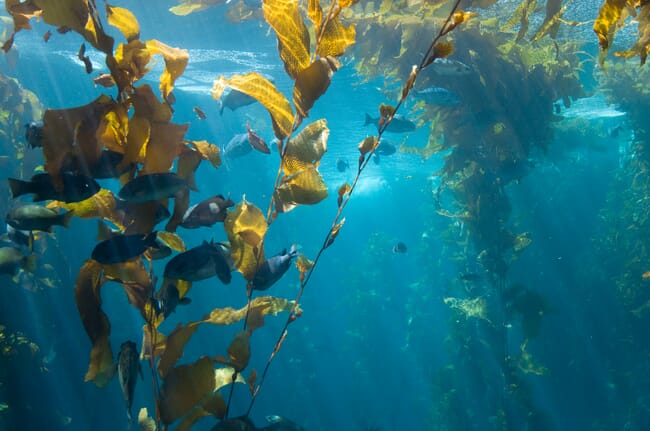
Blue carbon is gaining more attention from policymakers and market analysts as a way to offset greenhouse gas emissions © Umitron
Blue carbon is gaining attention as an effective nature-based solution for carbon abatement – and its potential is veering from optimism to full-on hype. As the global climate and ocean crises become more pronounced, firms and policymakers are turning to blue carbon solutions as an innovative way to offset their greenhouse gas (GHG) emissions and put the global economy on a net-zero trajectory.
A recent report from McKinsey does a deep dive into the promise of blue carbon – citing the ability of mangroves, saltmarshes and seagrasses to sequester more carbon per hectare than terrestrial forests. The report also investigates the feasibility of seaweed aquaculture as a blue carbon offset strategy. Its case studies find that despite the potential of macroalgae carbon offsets, seaweed projects can’t be readily monetised on existing carbon markets. The underlying baselines and rich co-benefits are difficult to illustrate in current offset propositions.
McKinsey also found that the carbon credits produced by seaweed ventures are comparatively expensive, making it difficult for macroalgae to compete with more established forest-based carbon credits. Though it might be possible – and potentially critical – for kelp and seaweed projects to overcome their challenges to become viable carbon offsets, the way offsets are designed may keep macroalgae as an emerging solution instead of an established one.
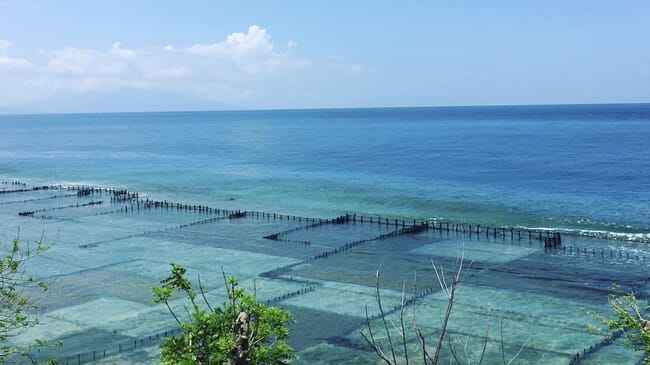
The way carbon offsets are designed may prevent macroalgae blue carbon from reaching its potential © Umitron
The components of a carbon credit and a carbon offset
A carbon credit is a loose term for any tradeable certificate that “allows” a firm to emit a set amount of greenhouse gasses – one credit is usually equivalent to one tonne of CO₂ (or its equivalent in another GHG). In this system, emissions are capped and then carbon markets are used to “allocate” the emissions among a group of regulated sources.
Carbon credits and the markets where they’re traded can help mitigate GHG emissions because they give a monetary value to polluting the environment – turning CO₂ into a visible business expense. Since credits are issued to bodies that curtail their climate emissions, credits can be used to finance carbon reduction schemes around the world.
The key difference between a carbon credit and a carbon offset is whether GHGs are being emitted or negated. A carbon credit confers the right to emit CO₂, while carbon offsets represent the production of a certain amount of sustainable energy or preserved ecosystem that counterbalances the use of fossil fuels. This counterbalancing effort generates a carbon credit. Most blue carbon and nature-based climate solutions strategies fall into this category.
To court stakeholders and financing, carbon offsetting projects need to demonstrate that their climate impacts are “real”, “quantifiable” and “verifiable”. These concepts, which form the cornerstone of the Core Carbon Principles, are difficult to pin down – so practitioners have identified three key components that establish the offset’s quality.
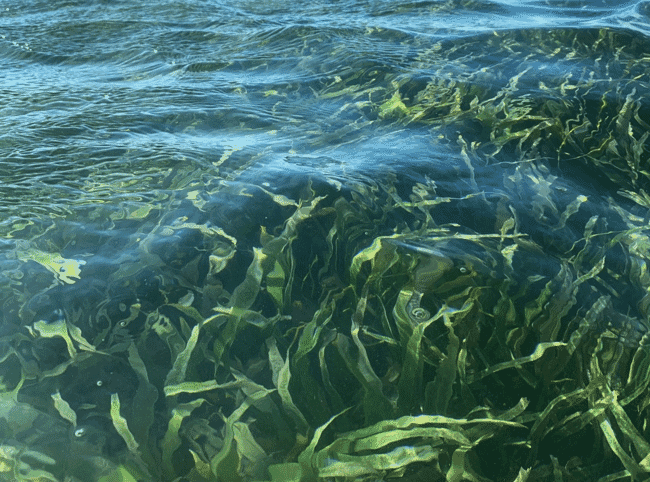
The key difference between a carbon credit and a carbon offset is whether GHGs are being emitted or negated.
The carbon offset triangle
Carbon offsets need to address three core elements to meet their climate goals: permanence, leakage and additionality. In blue carbon offsets, permanence means that the marine ecosystem being preserved or restored must remain intact for enough time to meet its carbon sequestration goals. Practitioners need to know how long the mangroves and macroalgae will remain in situ without experiencing illegal harvesting or habitat degradation.
Blue carbon projects also need to make sure that the carbon they’re sequestering won’t just lead to unintended and increased emissions outside the project boundary – the carbon can’t “leak” into other areas of the biosphere. A potential example of carbon leakage would be restoring a patch of mangroves and having a shrimp farmer remove them as his farm footprint expands. This would negate any potential carbon sequestered by the project – the leakage means that no emissions were offset.
The final element of the offset triangle is additionality. Blue carbon offsets need to demonstrate that the coastal area they are preserving would not have been protected otherwise; and that the climate benefit they render is “additional” to the status quo. Additionality is an – admittedly – opaque way of describing “what would have happened anyway” in a marine ecosystem. If a coastal habitat was never going to be destroyed, then being paid to maintain it is a false investment. Blue carbon offsets need to protect threatened ecosystems to meet their goals.
Demonstrating these three elements allows carbon offsets to establish a verifiable baseline – or the amount of carbon sequestered. In addition to this baseline, carbon offsets need to prove that they aren’t “double counting” the carbon they store. If a nature-based offset solution can meet these benchmarks, it lends itself easily to carbon markets and stakeholder investment. But – as McKinsey notes – few blue projects meet this standard. Blue carbon isn’t necessarily an offsetting slam-dunk.

McKinsey's report outlined three broad categories of blue carbon offset projects © McKinsey
The three types of blue carbon solution
McKinsey put the various blue carbon initiatives into three broad categories: established, emerging and nascent. “Established” solutions meet the minimum standards of scientific understanding and implementation potential – practitioners can fulfil the criteria of the offset triangle and can quantify exactly how much carbon they are abating with their efforts. These projects tend to focus on protecting and restoring mangroves, saltmarshes and seagrass meadows. Established blue carbon solutions tend to gain more traction because they can be funded and monetised through existing carbon markets. The two most notable examples are the Mikoko Pamoja and Cispatá Bay mangrove projects in Kenya and Colombia respectively.
“Emerging” blue carbon solutions are those that have a body of peer-reviewed research verifying their carbon-abatement potential, but don’t meet the calibre of established projects. These projects may fall short on the scientific side – when researchers can’t draw concrete conclusions about their impacts. McKinsey put seaweed farming and kelp forest restoration in this category. Emerging blue carbon initiatives may struggle to align with current funding frameworks like the Core Carbon Principles – making it hard to put these projects on voluntary carbon markets.
“Nascent” blue carbon initiatives tend to boast benefits that are – at this stage – theoretical. Most projects involve protecting and restoring corals and marine fauna populations. Advocates argue that marine life is carbon-based, and that preserving these populations ensures that the biological “carbon pump” of different ecosystems is functioning properly. Maintaining this pump allows carbon to be exported into the deep sea, where it can be sequestered.
Though preserving marine fauna would certainly yield an ecosystem and biodiversity benefit, fish themselves aren’t considered a form of carbon sequestration. These solutions also face a key challenge on the financial side. Researchers and investors can’t easily understand or quantify the impacts – whether positive or negative – of nascent solutions. It’s difficult to establish the permanence, leakage and additionality in these systems. Since we can’t quantify how these solutions and organisms trap and sequester carbon, the category isn’t financeable through carbon markets.
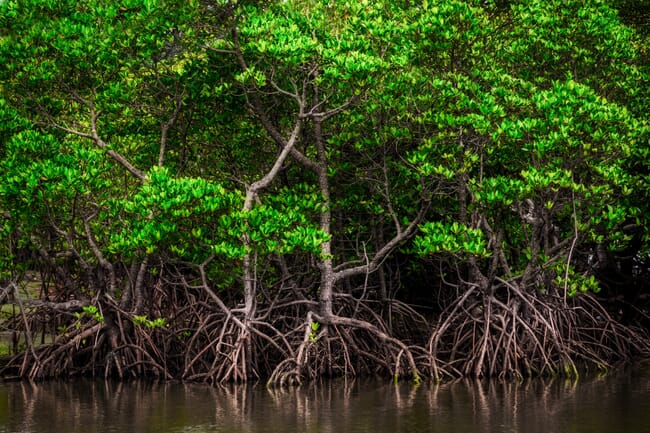
Mangrove projects tend to gain more traction because they can be funded and monetised through existing carbon markets
How does seaweed stack up?
McKinsey puts kelp forest restoration and seaweed aquaculture firmly in the “emerging solutions” category. Seaweed ecosystem remediation is attractive to carbon offset projects as the plants absorb CO₂ when they photosynthesise and because seaweed habitats have been degraded by pollution and rising ocean temperatures. The sheer abundance of macroalgae is another boon – the plants cover 3.4 million square kilometres of ocean terrain.
When looking at kelp specifically, the picture becomes more compelling. Kelp covers 1.5 million square kilometres of the ocean floor and can grow by as much as 60 cm per day. This productivity means that kelp forests can capture more carbon per unit area than land-based rainforests.
The key reason macroalgae falls into the “emerging solutions” bracket while mangroves and seagrasses occupy the “established” one lies in where the plants sequester carbon. Mangroves, saltmarshes and seagrass store the bulk of the carbon they capture in soil, removing it from the atmosphere for a long period. By contrast, seaweed and kelp store carbon in their biomass, meaning that the sequestered carbon may disintegrate and make its way back into the atmosphere if the seaweed is destroyed. Some studies estimate that globally, seaweeds sequester 0.6 gigatonnes of CO₂ equivalent each year in seafloor sediments (McKinsey puts the range between 0.2 and 1.0 GtCO₂). Kelp forests potentially account for one-third of the sequestration total, assuming an absorption rate of 1.4 tonnes of CO₂ per hectare each year.
Remediation efforts for macroalgae ecosystems – like protections from overharvesting and culling urchin populations – face notable hurdles for blue carbon financing. Researchers haven’t been able to fully track and measure the amount of carbon sequestered in kelp forests. The impact of climate change on kelp growth is also uncertain, making the long-term viability of projects uncertain. In addition to these theoretical concerns, kelp and seaweed can drift outside the boundaries of offset projects. This makes it nearly impossible to set baselines like permanence and leakage.
The report authors also note that different blue carbon interventions with kelp can be pricey. Controlling urchin populations is relatively cost-effective, but transplanting and replanting macroalgae is expensive. The price per tonne of CO₂ abated for kelp projects ranges between $21 and $10,000 – the median price per tonne of CO₂ abated is $6,400. This makes the costs highly uncertain. Even lower-range estimates are unrealistic for wider application.
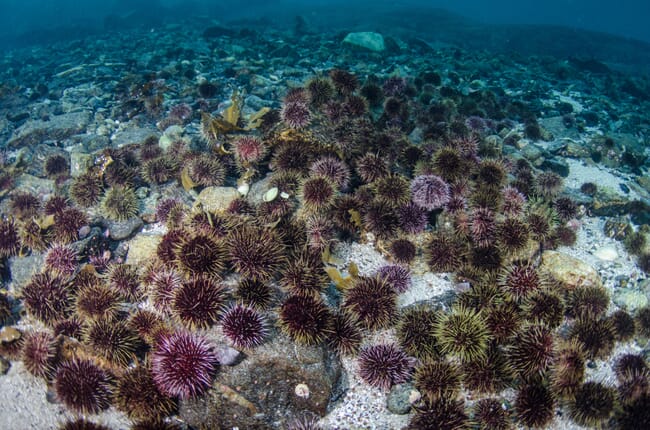
Many kelp forests have been overgrazed and destroyed by sea urchins © Urchinomics
Where seaweed aquaculture meets blue carbon
Farming kelp and other macroalgae species could abate atmospheric carbon in two ways. Producers could grow biomass and sink it into the water – well below 1,000 metres. This method would probably remove carbon from the atmosphere for centuries, but it doesn’t provide immediate economic returns for the producer.
The second option is the conventional farming approach, where producers grow biomass and harvest it for consumption or processing into other products. This wouldn’t capture carbon permanently. However, seaweed farming could gain traction as an offset strategy because it could displace carbon-intensive activities like offshore drilling.
The estimated cost of carbon sequestered per hectare of ocean area with farmed seaweed comes in at around $200 to $300 per tonne of CO₂ abated. However, if seaweed farmers can achieve economies of scale, costs could drop to about $50 to $80 per tonne. If costs can be reduced, then there is almost no limit for ocean afforestation. The marine environment is vast and the implementation potential is high.
Translating this potential into a bankable blue carbon project gets a bit trickier. The report authors prefer the seed and sink method instead of conventional farming. They estimate that for seaweed aquaculture to sequester 1.0 gigatonnes of CO₂ equivalent each year – roughly the same amount of carbon offset in established blue carbon solutions – farm footprints would have to increase by 0.9 million square kilometres. Finding suitable space may not be the issue. Instead, the industry needs to reduce costs and develop successful pilot projects before it can advertise seaweed farming as a high-quality carbon offset.
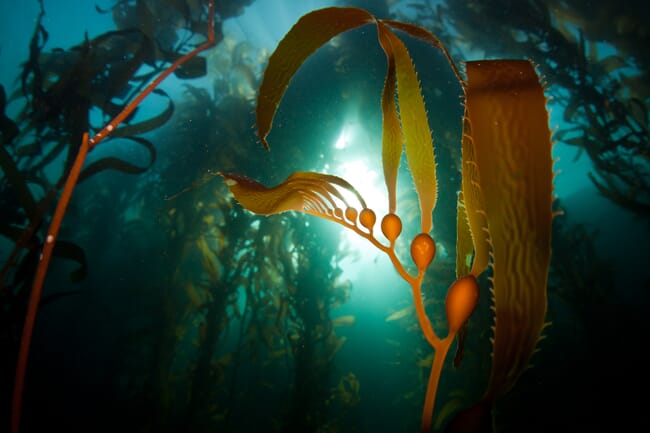
Translating carbon abatement potential into a blue carbon project is tricky. © Kelp Blue
Quantifying the co-benefits
Carbon offsets are not created equal – and translating a forest-based carbon offset into a seaweed blue carbon project illustrates this point. Seaweed growers rightly point out that their work generates multiple co-benefits that aren’t accounted for in blue carbon financing or the offset triangle.
In addition to storing carbon, macroalgae can store nitrogen, making it useful in ameliorating pollution and agricultural run-off. Seaweed populations can also help reduce ocean acidification and clean up excessive nutrient concentrations along the coast. One case study found that seaweed farms helped restore oxygen-depleted “dead zones” in the Gulf of Mexico. The biodiversity benefits of restoring macroalgae could also jumpstart ecotourism and additional income opportunities for coastal residents.
Seaweed’s potential for nutraceuticals and feed additives might make the seed and sink carbon offset less appealing. Studies on the red seaweed Asparagopsis taxiformis found that including it in cattle feed rations can reduce enteric methane emissions by as much as 98 percent. This potential benefit would be lost if the seaweed remained in the water – illustrating that some downstream boons aren’t captured when institutions pitch seaweed blue carbon projects. The fundamental assumptions of carbon offsets may need to be re-imagined to make them applicable for marine environments.
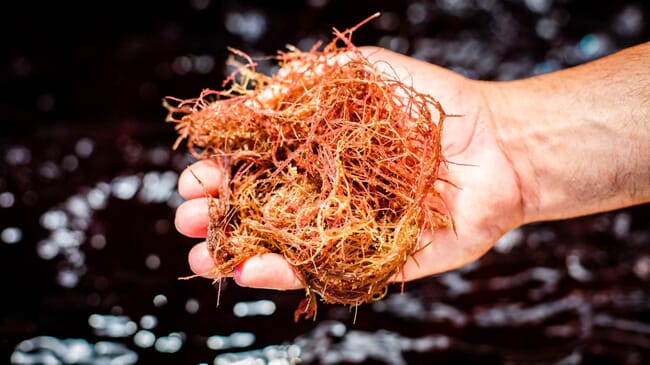
Seaweed-based carbon offsets often require producers to leave biomass in the water, potentially missing out on the myriad of downstream applications for seaweed © CH4 Global
Looking at the data
The mainstream hype and attention around blue carbon might lead stakeholders to think that it’s a climate panacea – but the reality is much more complex. The bulk of projects can’t meet the standards of existing carbon markets. If blue carbon solutions can’t demonstrate permanence, additionality and prevent leakage, they won’t access the financing they need to scale up.

© McKinsey
There are also multiple unknowns with macroalgae that might be risky. Hypothetically, the nutrients absorbed by a large-scale seaweed farm might deprive phytoplankton populations of the nutrients they need to grow. In another example, growing seaweed on large, floating artificial structures could impact marine life in unknown ways. Unless these factors can be accounted for, macroalgae blue carbon may remain a theoretical solution.
McKinsey’s analysis found that if all three categories of blue carbon offset successfully came online and met their sequestration goals, they would abate between four and five gigatonnes of CO₂ annually. This is equal to offsetting between 7 and 10 percent of the 40 gigatonnes of carbon we emit each year. Even in blue carbon’s most optimistic implementation and impact scenario, it isn’t a get-out-of-jail-free card. We still need to do the hard work of decarbonising our economies.
Despite this reality check, blue carbon is a significant and underutilised source of carbon abatement. If practitioners can collaborate to perfect their pilot projects and invest in the technologies they need, blue carbon could gain momentum and come online. “The scale of the solution is too large to ignore,” McKinsey says. “There is work to do, but the direction is clear: consideration of blue carbon solutions is both merited and recommended.”




